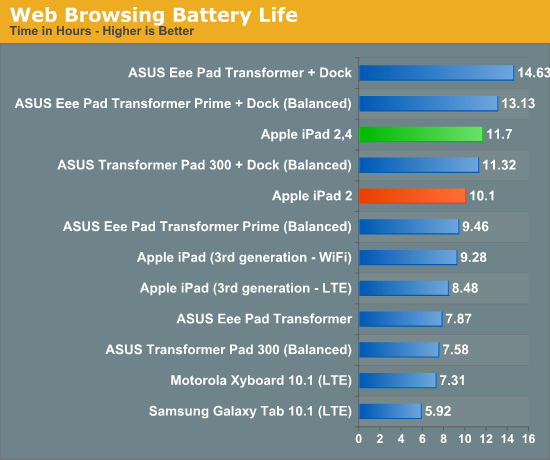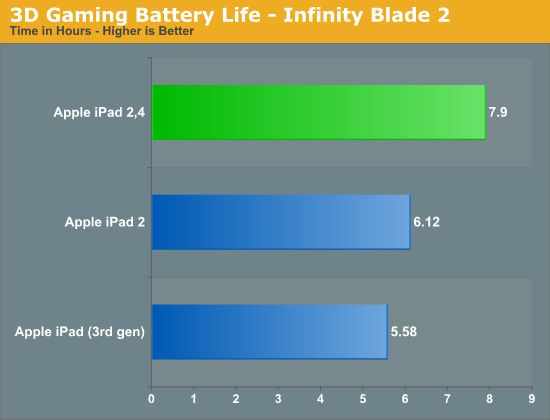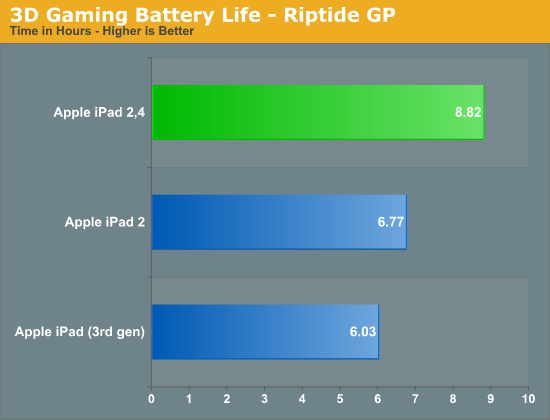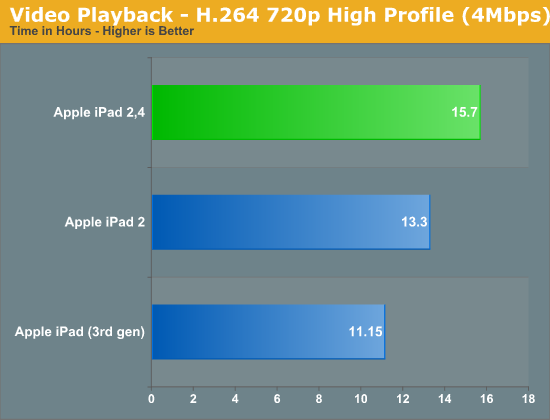The iPad 2,4 Review: 32nm Brings Better Battery Life
by Anand Lal Shimpi on May 4, 2012 12:50 AM ESTSignificant Battery Life Improvements
We'll start with the latest iteration of our WiFi web browsing test. With some additional logic to defeat overly aggressive browser caching, this test cycles through dozens of web pages, pausing on each one to simulate reading time before moving onto the next one. Display brightness is kept constant at 200 nits while the test runs. Results are reported in hours of battery life before the tablet dies.

Most web browsing tests end up being significantly display limited, as in the display dominates most of the power draw. That being the case, the fact that we see a 15.8% increase in battery life from the new 32nm HK+MG SoC alone is very significant. Apple is very conservative internally about revising battery life ratings so it's no surprise that we don't see a change in the specs on the iPad 2, especially considering that so many units out there on the market are still older iPad 2,1 models.
The increase in battery life here is almost certainly due to lower leakage at idle and better active power as well. This is a real improvement.
Things get even better when we stress the real power hog on the SoC: Imagination Technologies' PowerVR SGX 543MP2 GPU. Taking up more area on the die than the dual Cortex A9 cores, the 543MP2 is really stressed during 3D gaming. What better way to measure the impact of the new 32nm SoC on battery life than with one of the most stressful 3D games out for iOS today: Infinity Blade 2.
Here we're looping through the same scene until the battery dies, once again at normalized brightness.

The 3rd generation iPad obviously doesn't do as well as the iPad 2 here, as it not only has a more power hungry GPU but it's also rendering the scene at a higher resolution (and driving a higher resolution panel). What's most impressive however is just how much better the iPad 2,4 does here: a 29% increase in battery life over the original iPad 2,1.
Riptide GP, a less stressful title, shows us similar results:

Finally we have our brand new video playback test. Here we've got a copy of the last Harry Potter movie with the credits stripped out (1:58:00 running time), transcoded to a 720p High Profile H.264 video with a 4Mbps average bit rate, playing back in a loop until the battery dies.

The iPad 2 holds a 19% advantage over the 3rd generation iPad (once again for obvious reasons), however the iPad 2,4 absolutely dominates with an 18% increase in battery life. At 15.7 hours this is an insane amount of battery life from a single charge. Granted end users will see lower numbers if you watch at higher brightness settings (200 nits on our test panel was around 40% brightness), but the advantage from the new iPad should still remain just as significant.










100 Comments
View All Comments
PeteH - Friday, May 4, 2012 - link
Was video testing done full screen or letterboxed? Assuming it was done letterboxed, is it possible that backlighting of the display can be selectively turned off near the top and bottom of the screen? That would definitely save power.It'd be easy enough to test. Just run the test full screen and see if the playback time changes.
dagamer34 - Monday, May 7, 2012 - link
Backlight works across the entire display. There is no local dimming.jjj - Friday, May 4, 2012 - link
Not so sure the foundry part is working all that well,they didn't had 32nm for the ipad 3 and they had to cut a few corners without it (huge battery- ads cost , weight and bulk , way hotter , moving the ram on the other side of the PCB ).You put a positive spin on the way they transitioned to 32nm but there is no reason to keep the 32nm part low vol,and not transition all ipad 2 SKUs if Samsung has capacity and yields are good so something might not be quite there just yet. I always thought the ipad 3 on 45nm was a plan B device and Apple having A5 on 32nm this early makes it look even more so.
BSMonitor - Friday, May 4, 2012 - link
Sure there is. Apple has no control of the volume for the A5X if they have TSMC move to a new node and try and build a new SoC on it. We have seen ALL CPU/GPU manufacturers struggle with yield when transitions to new nodes coincide with new designs. So rather risk holding back 30 million iPad 3's to a April, May, June launch, they took the risk of low yields out of the equation and stuck with 45nm.Remember, any transition to a new node for any chip maker is typically a different Fab. And/or retooling existing Fabs. So as new 32nm Fab's come online, they won't be anywhere near the capacity of 45nm Fab's for some time.
We don't mention this much, because Intel has made this seem almost immaterial. But it is a BIG deal, and VERY expensive to ramp new nodes. Look at AMD, this side of the game would have eventually bankrupted them due to the expense of it all.
BSMonitor - Friday, May 4, 2012 - link
Err. Samsung not TSMC.. LOLltcommanderdata - Friday, May 4, 2012 - link
It's not just the iPad 3 that would find a 32nm shrink useful. With it's higher battery consumption, it's interesting that Apple didn't decide to use the 3G iPad 2 as the 32nm A5 testbed. The 3G iPad 2 is also presumably a lower volume product than the WiFi iPad 2 which also works in it's favour as a pilot. Would an SoC change still require a new round of carrier/government radiation testing, since that would be a major disincentive?It's good that you found the performance of the iPad2,4 unchanged. Your previous new AppleTV articles mentioned that it was coupled with a single 512MB LPDDR2 RAM die indicating only a single 32-bit channel memory configuration. It looks like the 32nm A5 in the iPad 2,4 implements the full 2x64-bit memory system.
Given the smartphone GPU performance showing in the Exynos 4412, if Apple wants to regain the GPU performance crown and hold it into 2013 when Rogue shows up, they'll probably need to be more aggressive than an up-clocked 32nm A5 in the iPhone 5. The 32nm A5 looks like a shoe-in for the next iPod Touch though.
André - Friday, May 4, 2012 - link
Why?Everything in iOS is synced to 60Hz, which SGX543MP2 already does at 960 x 640.
Sure you could always add more eye candy.
gevorg - Friday, May 4, 2012 - link
Not sure why Apple would be so conservative about rolling out the 32nm process with such a limited run for more than half of 2012, while Samsung just released their Galaxy S3 build on 32nm and ready to sell like hotcakes.KoolAidMan1 - Friday, May 4, 2012 - link
Apple is selling every single iPad that they make. Potential supply constraints from a new process is a huge risk to take. Low initial yields are a common bottleneck for new products, look at what is happening with the GTX 680 right now.They weighed the pros and cons and decided to go with what is proven, tradeoff being the absolutely massive A5X SoC.
Also note that new iPad production started late last year. Just a few months makes quite a difference, which is why we'll soon be seeing 32nm in upcoming smartphones.
BSMonitor - Friday, May 4, 2012 - link
Actually, the Galaxy S3 accounts for a fraction of the new Ipads necessary for its launch.